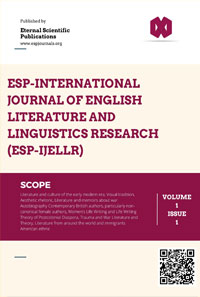ESP International Journal of English Literature and Linguistics Research (ESP-IJELLR)
Citation :
D. Sivamanikandan, R. Vijaya Kumar, 2025. "Gender Representation in Gothic Novels: An Analysis of Female Protagonists and Antagonists" ESP-International Journal of English Literature and Linguistics Research (ESP- IJELLR) Volume 3, Issue 3: 10-16.
Abstract :
Since the late eighteenth century, gothic literature has offered a way to explore societal fears through gender roles, identity and power. Certainly in the development of character traits which seek to be challenging, whether negative (epistemic patriarchs) of positive (resistant subalterns), philosophy separates itself from other academic disciplines working with characters and knowledges. Looking at the portrayal of female heroines and anti-heroines in gothic literature, this essay attempts to explore how historical perceptions reflect cultural perceptions of women. The female characters as represented by Horace Walpole in The Castle of Otranto (1764) function merely as tools to accentuate male heroism, thereby confirming the patriarchal ideals of their era. Early Gothic text's central heroines are passively innocent, helpless and morally good - the absolute 'damsel in distress' (64). But as the genre continued to develop, with writers like Mary Shelley and Ann Radcliffe, heroines started to demonstrate more independent moral agency and resilience. Emily, from Radcliffe’s The Mysteries of Udolpho (1794), accepts women as fellow agents instead of an hopeless object to be defended, facing fear and adversity with courage and intelligence. Like this is the case with Frankenstein, Shelley’s (1818), which very subtly satirizes the suffocating limits society imposes on women through scrutinizing social and domestic structures and demonstrating that to deny a woman access to moral or intellectual reach results in harm.The Gothic also presents female villains as rebellious subject butnt of patriarchal norms who often oppose to this authority through ambition, jealousy or rebellion. Characters such as the eponymous Rebecca in Du Maurier’s 1938 novel, Rebecca, show how women can have influence by not being there at all — undercutting solidified hierarchies and pushing gendered and domestic norms to the breaking point. Even when these satanic portrayals are somewhat cloaked in the guise of wickedness or unrighteousness, they underscore issues regarding the empowerment of women within literary and social settings. This essay examines the distribution of victim-blaming and agency by exposing tensions between female protagonists and antagonists in Gothic literature. It illustrates how gender stereotypes are both reinforced and subverted through the genre. The analysis also explores how Gothic fiction anticipates current debates around women's autonomy, authority, and representation in cultural texts while situating these figures within broader feminist discourses. By close analysis of texts and critical concepts, the study demonstrates how Gothic fiction offers a model for understanding gender constructions in relation to history and culture and charts the continuing relevance of this hugely popular cultural form for feminist, literary studies.
References :
[1] Botting, F. (1996). Gothic. Routledge.
[2] Brontë, C. (1847). Jane Eyre. Smith, Elder & Co.
[3] Carter, A. (1979). The Bloody Chamber and Other Stories. Gollancz.
[4] Cavallaro, D. (2002). The Gothic Vision: Three Centuries of Horror, Terror and Fear. Continuum.
[5] du Maurier, D. (1938). Rebecca. Victor Gollancz Ltd.
[6] Ellis, K. (2000). The Contested Castle: Gothic Novels and the Subversion of Domestic Ideology. University of Illinois Press.
[7] Fussell, P. (1975). The Great War and Modern Memory. Oxford University Press.
[8] Gilbert, S. M., & Gubar, S. (1979). The Madwoman in the Attic: The Woman Writer and the Nineteenth-Century Literary Imagination. Yale University Press.
[9] Godwin, W. (1794). Things as They Are; or, The Adventures of Caleb Williams. G.G.J. and J. Robinson.
[10] Hogle, J. E. (Ed.). (2002). The Cambridge Companion to Gothic Fiction. Cambridge University Press.
[11] Hoeveler, D. L. (1998). Gothic Feminism: The Professionalization of Gender from Charlotte Smith to the Brontës. Pennsylvania State University Press.
[12] Moers, E. (1976). Literary Women: The Great Writers. Oxford University Press.
[13] Morrison, T. (1987). Beloved. Alfred A. Knopf.
[14] Punter, D., & Byron, G. (2004). The Gothic. Blackwell Publishing.
[15] Radcliffe, A. (1794). The Mysteries of Udolpho. G.G. and J. Robinson.
[16] Sagas of She. (2019). The Monstrous Feminine in Gothic Literature: Female Villains and Power. Sagas of She Journal of Gender Studies, 12(3), 55–70.
[17] Shelley, M. (1818). Frankenstein; or, The Modern Prometheus. Lackington, Hughes, Harding, Mavor & Jones.
[18] Showalter, E. (1991). Sister’s Choice: Tradition and Change in American Women’s Writing. Oxford University Press.
[19] Smith, A. (2004). Gothic Literature. Edinburgh University Press.
[20] Williams, A. (2010). Art of Darkness: A Poetics of Gothic. University of Chicago Press.
Keywords :
Female Protagonists and Antagonists, Gender Portrayal, Feminist Criticism Victorian Literature, Literary Analysis, Ann Radcliffe, Mary Shelley, Daphne Du Maurier Gothic Literature.


 :10.56472/25842773/IJELLR-V3I3P102
:10.56472/25842773/IJELLR-V3I3P102